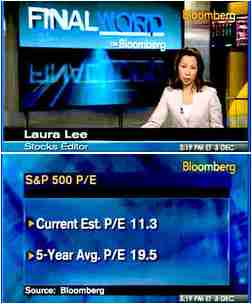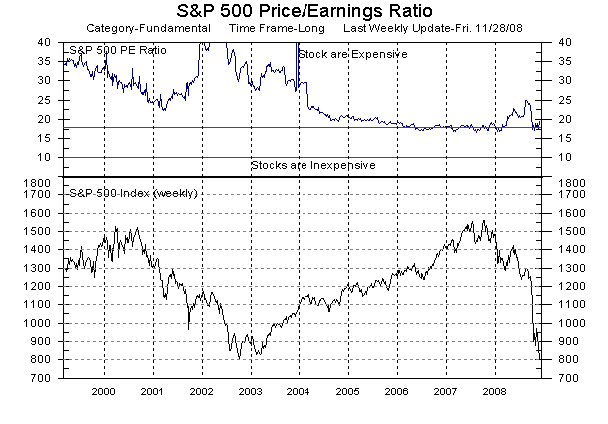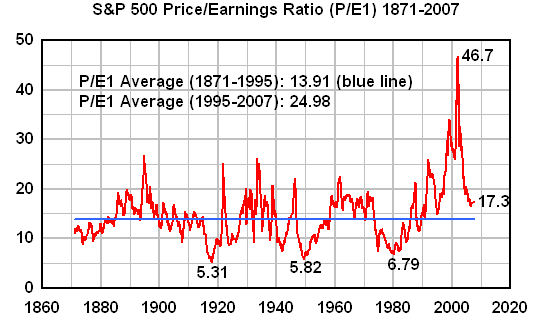
Dynamics

|
Generational Dynamics |
| Forecasting America's Destiny ... and the World's | |
| HOME WEB LOG COUNTRY WIKI COMMENT FORUM DOWNLOADS ABOUT | |
This 'analysis' is breathtaking in its sheer stupidity.
According to a research note by UBS AG analyst David Bianco, reported by Bloomberg, the S&P 500 index will surge from its current 870 to 1300 by the end of 2009. Presumably this also means that the Dow Industrials index will surge from its current 8600 to 13,000.
According to Bianco, "The consensus outlook for 2009 is a full year of gloom. We believe 2009 will bring signs of a dawn in confidence with the first faint light appearing earlier than most investors expect."
Bianco opines further that the various bailouts will restore confidence in the markets, and then, "Once this happens, powerful positive underlying economic forces such as the worldwide proliferation of technology and globalization should make confidence shine again." Whoo!
Unfortunately, Bianco's actual research note is not available (at least to me), so I transcribed Bloomberg TV coverage of this story:
 |
The S&P 500 has taken a beating this year, down more than 40%, right around that 860 level.
UBS predicts the index will recover those losses, rising about 53% to (get this) 1300 by the end of 2009.
So how cheap are US stocks right now?
Well, the S&P 500 is valued at 11.3 times estimated earnings, on average over the past 5 years, the index has traded at more than 19 times earnings. So a discount there.
It's not just the US stocks that could be poised for a turnaround. UBS predicts the UK's FTSE 100 will rise almost 40% to the 5800 level next year.
Now we should note that UBS is a lot more bullish on stocks than a lot of Wall Street firms. Citigroup for one last month cut its 2009 forecast for the S&P 500 to 1000.
And UBS's prediction for the index this year hasn't fared so well. Bianco predicted a gain of 16%. So the jury is still out, but we are slowly hearing a bit more optimism, after what's been a very tough year for equities."
Notice the screen shot above, showing the current estimated P/E as 11.3, and the average for the last 5 years as 19.5.
Now first off, where the hell did that 11.3 figure for the current estimated P/E come from?
There's a price/earnings ratio chart at the bottom of this web site's home page, and it gets updated automatically every Friday. Here's last Friday's version of the chart:
 |
As you can see for yourself, the current P/E index is around 19, nowhere near 11.3. The average for the past 5 years is a little above 19.5, but let's say 19.5 for the sake of argument.
The P/E index is computed by dividing the price for a share of stock by the earnings per share for the stock. It's not rocket science. So where did the 11.3 come from?
Well, actually I know where he got 11.3 from. He got it from something called "forward earnings." He estimated that corporate earnings will increase by 25-50% next year, and used that hugely bloated figure to compute a P/E ratio of 11.3.
Now this guy probably earns a 6-figure salary, but he's a total moron. The Bloomberg story gives his age as 33, meaning that he's at the leading edge of the young Millennial generation. He works in New York for a Swiss bank, but I'm willing to bet he's too dumb to be able to pick out Switzerland on a map.
So let's make a list of all the mistakes he's made:
In fact, what's really incredible is that this genius used circular reasons:
Have you heard of "first-in, first out" or FIFO? Well, this analyst uses a different technique: Garbage-in, garbage-out, or GIGO.
I know, Dear Reader, that some of you criticize me for calling these people idiots, but I just can't get over this. This has got to be one of the stupidest analyses I've ever seen. How am I supposed to describe it?
But I shouldn't just pick on this one analyst, because he's no different from all the others.
Remember that UBS AG has lost the most of all the banks in Europe from investments in near-worthless mortgage-backed securities. These people aren't the sharpest knives in the drawer.
You may have noticed above that I said that the UBS must be assuming that earnings growth next year will be 25-50%. Where did I get that figure? It's been the same every quarter.
Here's an earnings growth estimate that I posted in February:
Period Earnings growth estimate (Thomson Financial) ------- -------------------------------------------- Q1 2008 2.6% Q2 2008 3.5% Q3 2008 20.0% Q4 2008 50.0%
All of these turned out to be wrong. Q1 earnings fell 17.5%, and Q2 earnings fell 22.1%.
Long-time regular readers know that I tabulate these earnings estimates from week to week. Here's the table for the third quarter earnings growth estimates:
Date 3Q Earnings growth estimate as of that date ------- ------------------------------------------- Mar 3: 25.0% Apr 1: 17.3% Start of previous (2nd) quarter Jul 1: 12.6% Start of quarter Sep 5: 0.8% Sep 12: -1.6% Sep 19: -0.3% Sep 26: -1.7% End of quarter Oct 3: -4.8% Oct 10: -7.8% Oct 17: -9.1% Oct 24: -11.0% Oct 30: -23.8% Nov 7: -13.9% Nov 14: -18.4% Nov 21: -18.5% Nov 28: -18.7%
As you can see, earnings are not expected to grow 25% this quarter; they're now expected to fall 18.7%, as actual earnings reports have been coming in.
Returning now to price/earnings ratios, here's a graph that I first posted a year ago in "How to compute the 'real value' of the stock market":
 |
The historic average of the P/E1 (price divided by one-year trailing earnings) is about 14. From 1995 to the present, it's averaged around 25, creating a huge bubble. By the Law of Mean Reversion, the price/earnings ratio will fall well below 10 for a dozen years or so. You can see that it's poised to fall quickly in the near future, leading to a stock market crash. That's the correct analysis of P/E ratios, not the garbage from UBS.
(Comments: For reader comments, questions and discussion, as
well as more frequent updates on this subject, see the Financial Topics thread of the Generational Dynamics forum. Read
the entire thread for discussions on how to protect your money.)
(4-Dec-2008)
Permanent Link
Receive daily World View columns by e-mail
Donate to Generational Dynamics via PayPal
Web Log Summary - 2016
Web Log Summary - 2015
Web Log Summary - 2014
Web Log Summary - 2013
Web Log Summary - 2012
Web Log Summary - 2011
Web Log Summary - 2010
Web Log Summary - 2009
Web Log Summary - 2008
Web Log Summary - 2007
Web Log Summary - 2006
Web Log Summary - 2005
Web Log Summary - 2004
Web Log - December, 2016
Web Log - November, 2016
Web Log - October, 2016
Web Log - September, 2016
Web Log - August, 2016
Web Log - July, 2016
Web Log - June, 2016
Web Log - May, 2016
Web Log - April, 2016
Web Log - March, 2016
Web Log - February, 2016
Web Log - January, 2016
Web Log - December, 2015
Web Log - November, 2015
Web Log - October, 2015
Web Log - September, 2015
Web Log - August, 2015
Web Log - July, 2015
Web Log - June, 2015
Web Log - May, 2015
Web Log - April, 2015
Web Log - March, 2015
Web Log - February, 2015
Web Log - January, 2015
Web Log - December, 2014
Web Log - November, 2014
Web Log - October, 2014
Web Log - September, 2014
Web Log - August, 2014
Web Log - July, 2014
Web Log - June, 2014
Web Log - May, 2014
Web Log - April, 2014
Web Log - March, 2014
Web Log - February, 2014
Web Log - January, 2014
Web Log - December, 2013
Web Log - November, 2013
Web Log - October, 2013
Web Log - September, 2013
Web Log - August, 2013
Web Log - July, 2013
Web Log - June, 2013
Web Log - May, 2013
Web Log - April, 2013
Web Log - March, 2013
Web Log - February, 2013
Web Log - January, 2013
Web Log - December, 2012
Web Log - November, 2012
Web Log - October, 2012
Web Log - September, 2012
Web Log - August, 2012
Web Log - July, 2012
Web Log - June, 2012
Web Log - May, 2012
Web Log - April, 2012
Web Log - March, 2012
Web Log - February, 2012
Web Log - January, 2012
Web Log - December, 2011
Web Log - November, 2011
Web Log - October, 2011
Web Log - September, 2011
Web Log - August, 2011
Web Log - July, 2011
Web Log - June, 2011
Web Log - May, 2011
Web Log - April, 2011
Web Log - March, 2011
Web Log - February, 2011
Web Log - January, 2011
Web Log - December, 2010
Web Log - November, 2010
Web Log - October, 2010
Web Log - September, 2010
Web Log - August, 2010
Web Log - July, 2010
Web Log - June, 2010
Web Log - May, 2010
Web Log - April, 2010
Web Log - March, 2010
Web Log - February, 2010
Web Log - January, 2010
Web Log - December, 2009
Web Log - November, 2009
Web Log - October, 2009
Web Log - September, 2009
Web Log - August, 2009
Web Log - July, 2009
Web Log - June, 2009
Web Log - May, 2009
Web Log - April, 2009
Web Log - March, 2009
Web Log - February, 2009
Web Log - January, 2009
Web Log - December, 2008
Web Log - November, 2008
Web Log - October, 2008
Web Log - September, 2008
Web Log - August, 2008
Web Log - July, 2008
Web Log - June, 2008
Web Log - May, 2008
Web Log - April, 2008
Web Log - March, 2008
Web Log - February, 2008
Web Log - January, 2008
Web Log - December, 2007
Web Log - November, 2007
Web Log - October, 2007
Web Log - September, 2007
Web Log - August, 2007
Web Log - July, 2007
Web Log - June, 2007
Web Log - May, 2007
Web Log - April, 2007
Web Log - March, 2007
Web Log - February, 2007
Web Log - January, 2007
Web Log - December, 2006
Web Log - November, 2006
Web Log - October, 2006
Web Log - September, 2006
Web Log - August, 2006
Web Log - July, 2006
Web Log - June, 2006
Web Log - May, 2006
Web Log - April, 2006
Web Log - March, 2006
Web Log - February, 2006
Web Log - January, 2006
Web Log - December, 2005
Web Log - November, 2005
Web Log - October, 2005
Web Log - September, 2005
Web Log - August, 2005
Web Log - July, 2005
Web Log - June, 2005
Web Log - May, 2005
Web Log - April, 2005
Web Log - March, 2005
Web Log - February, 2005
Web Log - January, 2005
Web Log - December, 2004
Web Log - November, 2004
Web Log - October, 2004
Web Log - September, 2004
Web Log - August, 2004
Web Log - July, 2004
Web Log - June, 2004